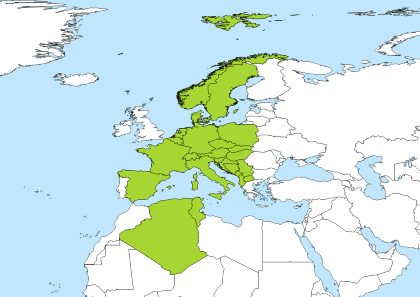CDT Caribbean to CET
Time Difference
Cuba Daylight Time is 6 hours behind Central European Summer Time
7:30 am07:30 in CDT is 1:30 pm13:30 in CEST
CDT to CET call time
Best time for a conference call or a meeting is between 8am-1pm in CDT which corresponds to 1pm-6pm in CET
7:30 am07:30 Cuba Daylight Time (CDT). Offset UTC -4:00 hours
1:30 pm13:30 Central European Summer Time (CEST). Offset UTC +2:00 hours
7:30 am07:30 CDT / 1:30 pm13:30 CEST
| CDT | CEST |
|---|---|
| 12am (midnight) | 6am |
| 1am | 7am |
| 2am | 8am |
| 3am | 9am |
| 4am | 10am |
| 5am | 11am |
| 6am | 12pm (noon) |
| 7am | 1pm |
| 8am | 2pm |
| 9am | 3pm |
| 10am | 4pm |
| 11am | 5pm |
| 12pm (noon) | 6pm |
| 1pm | 7pm |
| 2pm | 8pm |
| 3pm | 9pm |
| 4pm | 10pm |
| 5pm | 11pm |
| 6pm | 12am (midnight) |
| 7pm | 1am |
| 8pm | 2am |
| 9pm | 3am |
| 10pm | 4am |
| 11pm | 5am |
| 0:00 | 6:00 |
| 1:00 | 7:00 |
| 2:00 | 8:00 |
| 3:00 | 9:00 |
| 4:00 | 10:00 |
| 5:00 | 11:00 |
| 6:00 | 12:00 |
| 7:00 | 13:00 |
| 8:00 | 14:00 |
| 9:00 | 15:00 |
| 10:00 | 16:00 |
| 11:00 | 17:00 |
| 12:00 | 18:00 |
| 13:00 | 19:00 |
| 14:00 | 20:00 |
| 15:00 | 21:00 |
| 16:00 | 22:00 |
| 17:00 | 23:00 |
| 18:00 | 0:00 |
| 19:00 | 1:00 |
| 20:00 | 2:00 |
| 21:00 | 3:00 |
| 22:00 | 4:00 |
| 23:00 | 5:00 |
Cuba Daylight Time
Offset: CDT is 4 hours behind Greenwich Mean Time (GMT) and is used in Caribbean
Countries: It is used in following countries: Cuba
Principal Cities: The largest city in the CDT timezone is Havana from Cuba with population about 2.164 million people. Other major cities in the area are Santiago de Cuba, Camaguey, Holguin, Guantanamo
Daylight Saving: Cuba Daylight Time (CDT) is a daylight saving/summer timezone, however during winter some places switch clocks for one hour back and observe Cuba Standard Time (CST).
 Start: Cuba Daylight Time (CDT) started on Sunday, March 9, 2025 at 12:00 am local time and clocks were set one hour forward to Sunday, March 9, 2025, 1:00 am. Daylight saving starts annually the on second Sunday of March
Start: Cuba Daylight Time (CDT) started on Sunday, March 9, 2025 at 12:00 am local time and clocks were set one hour forward to Sunday, March 9, 2025, 1:00 am. Daylight saving starts annually the on second Sunday of March
 End: Cuba Daylight Time (CDT) ends on Sunday, November 2, 2025 at 1:00 am local time and clocks are set one hour back to Sunday, November 2, 2025, 12:00 am local standard time instead. Daylight saving ends annually the on first Sunday of November
End: Cuba Daylight Time (CDT) ends on Sunday, November 2, 2025 at 1:00 am local time and clocks are set one hour back to Sunday, November 2, 2025, 12:00 am local standard time instead. Daylight saving ends annually the on first Sunday of November
CDT representations, usage and related time zones
- -04 - basic short
- -0400 - basic
- -04:00 - extended
- -0400 - sign character (-) followed by a four digit time providing hours (04) and minutes (00) of the offset. Indicates four hour and zero minutes time differences to the west of the zero meridian.
- Quebec - Military abbreviation for CDT
- Q - short form of 'Quebec'
- America/Havana
- Cuba
- Central Daylight Time - UTC -5
- Cuba Daylight Time - UTC -4
- AST - Atlantic Standard Time
- EDT - Eastern Daylight Time
- AMT - Amazon Time
- BOT - Bolivia Time
- CDT - Cuba Daylight Time
- CLT - Chile Standard Time
- FKT - Falkland Island Time
- GYT - Guyana Time
- HLV - Hora Legal de Venezuela
- PYT - Paraguay Time
- Q - Quebec Time Zone
- VET - Venezuelan Standard Time
Central European Time
Offset: CET is 1 hour ahead Greenwich Mean Time (GMT) and is used in Europe
Countries: It is used in following countries: Andorra, Albania, Austria, Bosnia & Herzegovina, Belgium, Switzerland, Czech Republic, Germany, Denmark, Algeria, Spain, France, Gibraltar, Croatia, Hungary, Italy, Liechtenstein, Luxembourg, Monaco, Montenegro, North Macedonia, Malta, Netherlands, Norway, Poland, Serbia, Sweden, Slovenia, Svalbard & Jan Mayen, Slovakia, San Marino, Tunisia, Vatican City
Principal Cities: The largest city in the CET timezone is Berlin from Germany with population about 3.426 million people. Other major cities in the area are Madrid, Rome, Paris, Algiers
German: MEZ - Mitteleuropäische Zeit

Daylight Saving: This is a standard time zone, however during summer some places switch clocks for one hour forward when daylight saving comes into effect and observe Central European Summer Time (CEST).
 End: Central European Time (CET) has ended on Sunday, March 30, 2025 at 2:00 am local time and clocks were set one hour forward to Sunday, March 30, 2025, 3:00 am local daylight time instead. Standard time ends annually the on last Sunday of March.
End: Central European Time (CET) has ended on Sunday, March 30, 2025 at 2:00 am local time and clocks were set one hour forward to Sunday, March 30, 2025, 3:00 am local daylight time instead. Standard time ends annually the on last Sunday of March.
 Start: Central European Time (CET) starts on Sunday, October 26, 2025 at 3:00 am local time and clocks are set one hour back to Sunday, October 26, 2025, 2:00 am. Standard time starts annually the on last Sunday of October.
Start: Central European Time (CET) starts on Sunday, October 26, 2025 at 3:00 am local time and clocks are set one hour back to Sunday, October 26, 2025, 2:00 am. Standard time starts annually the on last Sunday of October.
CET representations, usage and related time zones
- +01 - basic short
- +0100 - basic
- +01:00 - extended
- +0100 - sign character (+) followed by a four digit time providing hours (01) and minutes (00) of the offset. Indicates one hour and zero minutes time differences to the east of the zero meridian.
- Alpha - Military abbreviation for CET
- A - short form of 'Alpha'
- Africa/Algiers
- Africa/Ceuta
- Africa/Tunis
- Arctic/Longyearbyen
- Atlantic/Jan_Mayen
- CET
- Europe/Amsterdam
- Europe/Andorra
- Europe/Belgrade
- Europe/Berlin
- Europe/Bratislava
- Europe/Brussels
- Europe/Budapest
- Europe/Busingen
- Europe/Copenhagen
- Europe/Gibraltar
- Europe/Ljubljana
- Europe/Luxembourg
- Europe/Madrid
- Europe/Malta
- Europe/Monaco
- Europe/Oslo
- Europe/Paris
- Europe/Podgorica
- Europe/Prague
- Europe/Rome
- Europe/San_Marino
- Europe/Sarajevo
- Europe/Skopje
- Europe/Stockholm
- Europe/Tirane
- Europe/Vaduz
- Europe/Vatican
- Europe/Vienna
- Europe/Warsaw
- Europe/Zagreb
- Europe/Zurich
- MET
- Poland
- BST - British Summer Time
- CET - Central European Time
- IST - Irish Standard Time
- WEST - Western European Summer Time
- A - Alpha Time Zone
- CET - Central European Time
- MEZ - Mitteleuropäische Zeit
- WAT - West Africa Time
- WST - Western Sahara Summer Time
- BMT - Biel Mean Time
